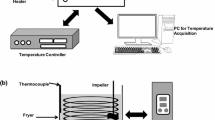Abstract
Physicochemical and instrumental characterization of rubber (Hevea brasiliensis Müll. Arg.) seed oil (RSO) was carried out for the purposes of quality assessment, identification, and authentication. Properties such as color (Lovibond), specific gravity, percent FFA (as oleic acid), acid value, saponification value, iodine value, and viscosity were determined. FA composition and M.W. averages of RSO were determined using GLC and gel permeation chromatography (GPC), respectively. Structural features of RSO were also determined using FTIR, 1H NMR, and 13C NMR spectroscopy. The natural form of RSO is highly acidic (acid value≈43.6 mg KOH/g). The saturated FA are palmitic (17.50%) and stearic (4.82%), and the main unsaturated FA are oleic (25.33%), linoleic (37.50%), and linolenic (14.21%). The oil can be classified as semidrying. GPC shows an unusual peak that is due to a very high M.W. (≈38,800) fraction that is not found in the chromatogram of known vegetable oils and is therefore unique to RSO. FTIR, 1H NMR, and 13C NMR analyses confirmed that RSO is composed mainly of TAG of saturated and unsaturated FA. Functional groups such as carbonyl, olefinic unsaturation, esters, glyceryl, methylene, and terminal methyl that are present in vegetable oils are also present in RSO.
Similar content being viewed by others
References
Fulmer, R.W., Trends in Industrial Use of Vegetable Oils in Coatings, J. Am. Oil Chem. Soc. 62:926–928 (1985).
Chiang, C., Allyl Esters and Allyl Epoxy Ester from Crambe Oil, 56:865–866 (1979).
Princen, L.H., New Crops Development for Industrial Oils, 56:848 (1979).
Pryde, E.H., Fats and Oils as Chemical Intermediates: Present and Future Uses, 56:849–854 (1979).
Abatua Borda, I., and M. Posada de la Paz, Clinic Findings, in Toxic Oil Syndrome: Current Knowledge and Future Perspectives, edited by World Health Organization, WHO Regional Publications, European Series, No. 42, World Health Organization, Copenhagen, 1991, p. 23–34.
Lorenzo, I.M., J.L.P. Pavon, M.E.F. Laespada, C.G. Pinto, and B.M. Corder, Detection of Adulterants in Olive Oil by Headspace Mass Spectrometry, J. Chromatogr. A 945:221–230 (2002).
Lawson, H.L., Food Oils and Fats: Technology, Utilization and Nutrition, Chapman & Hall, New York, 1994.
Christie, W.W. (ed.), Advances in Lipid Methodology, Vol. 1, Oily Press, Ayr, Scotland, 1992.
Christie, W.W. (ed.), Advances in Lipid Methodology, vol. 2, Oily Press, Ayr, Scotland, 1993.
Perkins, E.G., Nomenclature and Classification of Lipids, in Analyses of Fats, Oils and Lipoproteins, edited by E.G. Perkins, American Oil Chemists Society, Champaign, IL, 1991.
Neff, W.E., W.C. Byrdwell, and G.R. List, A New Method to Analyze Triacyglycerol Composition of Vegetable Oils, Cereal Foods World 46:6–10 (2001).
Aparicio, R., and R.A. Aparicio-Ruiz, Authentication of Vegetable Oils by Chromatographic Techniques, J. Chromatogr. A 881:93–104 (2000).
Blayo, A., A. Gandini, and J.F. Le Nest, Chemical and Rheological Characterizations of Some Vegetable Oil Derivatives Commonly Used in Printing Inks, Ind. Crop Prod. 14:155–167 (2001).
Lazarri, M., and O. Chiantore, Drying and Oxidative Degradation of Linseed Oil, Polym. Degrad. Stability 65:303–313 (1999).
Aigbodion, A.I., F.E. Okieimen, E.U. Ikhuria, I.O. Bakare, and E.O. Obazee, Rubber Seed Oil Modified with Maleic Anhydride and Fumaric Acid and their Alkyd Resins as Binder in Water-Reducible Coatings, J. Appl. Polym. Sci. 89:3256–3259 (2003).
Aigbodion, A.I., and C.K.S. Pillai, Synthesis and Molecular Weight Characterization of Rubber Seed Oil-Modified Alkyd Resins, 79:2431–2438 (2001).
Aigbodion, A.I., C.K.S. Pillai, I.O. Bakare, and L.E. Yahaya, Synthesis, Characterization and Evaluation of Heated Rubber Seed Oil and Rubber Seed Oil-Modified Alkyd Resins as Binders in Surface Coatings, Indian J. Chem. Technol. 8:378–384 (2001).
Okieimen, F.E., and J.E. Ebhoaye, Thermal Dehydrochlorination of PVC in the Presence of Metal Soaps Derived from Rubber Seed Oil, Eur. Polym. J. 28:1423–1425 (1992).
Okiemen, F.E., and J.E. Ebhoaye, Studies in the Thermal Degradation of Poly(vinyl chloride) J. Appl. Polym. Sci. 48:1853–1858 (1993).
Paquot, C., and A. Houffenne (eds.), Standard Methods for the Analysis of Oils, Fats and Derivatives, 7th edn., IUPAC, Blackwell Scientific, Oxford, 1987.
Aparicio, R., P. McIntyre, M. Aursand, E. Eveleigh, N. Marighetto, B. Rossell, R. Sacchi, R. Wilson, and M. Woolfe, Fish Oil, in Food Authenticity: Issues and Methodologies, edited by R. Aparicio, Eurofins Scientific, Nantes, 1998, p. 213.
ASTM D 2245-72, Identification of Oils and Oil Acids in Solvent-Type Paints, Annual Book of ASTM Standards, Part 29, ASTM, Gaithersburg, MD, 1979, pp. 362–366.
Payne, H.F., Organic Coating Technology, Vol. 1, John Wiley & Sons, New York, 1954, pp. 1–131, 605.
Koenig, H. (ed.), Rubber Seed Processing for the Production of Vegetable Oil and Animal Feed. Phase I: Literature Review, Field Studies Laboratory Tests and Product and Process Development Perspectives, United Nations Industrial Development Organization, 1987.
Oil and Colour Chemists' Association of Australia, Surface Coatings, Vol. 1: Raw Materials and Their Uses, Chapman & Hall, London, 1981.
Husain, S., G.S.R. sastry, and N.P. Raju, Molecular Weight Averages as Criteria for Quality Assessment of Heated Oils and Fats, J. Am. Oil Chem. Soc. 68:822–826 (1991).
Fraser, J.G., N.M. Peacock, and A.W. Pross, in Analysis of Resin Based Coating Materials, edited by C.P.A. Kappelmeir, Interscience, New York, 1959, pp. 407–444.
Gunstone, F.D., J.L. Harwood, and F.B. Padley (eds.), The Lipid Handbook, 2nd edn., Chapman & Hall, London, 1994.
Author information
Authors and Affiliations
Corresponding author
About this article
Cite this article
Aigbodion, A.I., Bakare, I.O. Rubber seed oil quality assessment and authentication. J Amer Oil Chem Soc 82, 465–469 (2005). https://doi.org/10.1007/s11746-005-1095-0
Received:
Accepted:
Issue Date:
DOI: https://doi.org/10.1007/s11746-005-1095-0




